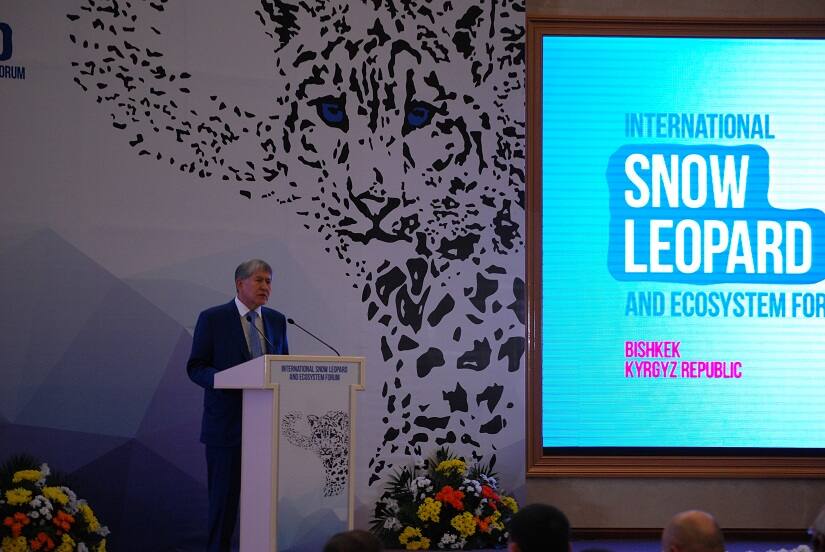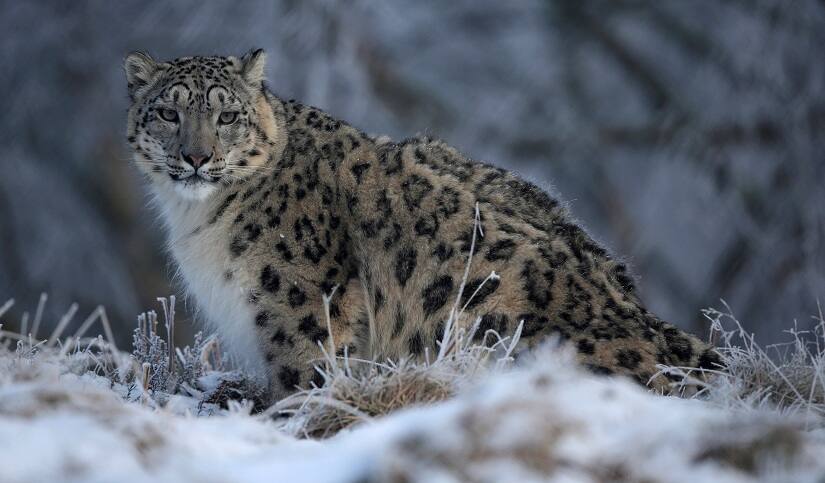Its blistering blue eyes stare curiously at the gathered audience. It takes a few stealthy steps forward. Then cocking its head gently to one side it stops, its ears pricked. Half hunched — and still the grey rosette pattern of its fur melts in the white background. At an ambush position it could be ready to strike an unsuspecting ibex. Among the craggy mountain tops where the snow leopards moves, it is near impossible to decipher it from the rocks. But this particular one is staring from a video screen at a 200-strong audience of cabinet ministers, senior forest officials, scientists and conservationists that came together as part of the Global Snow Leopard and Ecosystems Protection (GSLEP) programme. At the GSLEP summit held in Bishkek, Kyrgyzstan between 24-25 August, the governments of 12 countries where snow leopards are found, committed to secure the future of these cats and pledged to protect the mountains they roam. “If the snow leopards are going to survive it will be because of GSLEP as only the governments have the authority and ultimately the resources for sustainable development and investments in conservation,” said Michael Despines, executive director of the Snow Leopard Trust. “This is the first time we have seen a consistent high level political dialogue about snow leopard conservation.” [caption id=“attachment_4002315” align=“alignnone” width=“825”]  The President of Kyrgyzstan Almazbek Atambayev addressing the GSLEP gathering[/caption] The stakeholders from the range countries have put together the Bishkek Declaration, an official document, that among other things, recognises Asia’s mountain ecosystems as a powerful thread that binds these countries culturally and spiritually. The countries acknowledge snow leopard as an indicator of healthy and resilient mountain ecosystem. They will also strive to ensure the cultural, social and economic well-being of mountain communities. “The snow leopard is the face of biodiversity of the high mountains. These are areas where glaciers are found and river systems emanate from,” said Keshav Varma, international adviser to the GSLEP Secretariat headquartered in Bishkek. “We have to save the high mountain ecology because these are the water towers of the world.” According to Varma, there were three main outcomes of the summit. One, raising funds to finance the activities of GSLEP Secretariat. A major focus area of the GSLEP program is passing on benefits of conservation to local communities. “If the local communities feel good about maintaining the ecology of the protected areas there will be less conflict with wildlife,” says Varma. “We are trying to make the snow leopard and local communities friends.” The second outcome is an attempt to create a partnership between industry and wildlife conservation. According to Varma, it is not entirely possible to fund big-ticket conservation initiatives solely on funds from the government. He is placing his bets on raising funds from the corporate sector. The third is a concentrated effort to find out reliable estimates of number of snow leopards across its vast range. This is a contentious issue among scientists studying these cats. One set pegs the numbers between 7,400-8,000 of these elusive animals in the wild while the other suggests there are less than 4,000. As a result of this uncertainty, the International Union for Conservation of Nature (IUCN), the governing body that draws up the status of species on its Red List, is likely to downgrade the snow leopard from ‘endangered’ to ‘vulnerable’. This could potentially have huge implications in conservation of these cats. [caption id=“attachment_4002317” align=“alignnone” width=“825”]  A snow leopard. Image via Reuters[/caption] The GSLEP programme was launched in 2013 for a period of seven years up to 2020. It has identified 20 areas across the range countries for protection of snow leopards. The recently concluded summit was a mid-term review of the program. In the lead up to the summit, each member country was expected to come up with a management plan detailing its strategy to protect the areas that fall under its jurisdiction. While Nepal has stolen a march over other member countries in making public its master plan to protect snow leopards for the next 10 years, India is yet to come up with one. Nepal is joined by five other countries that have put together their management plans till 2020. Along with India, five others lag behind in submitting their plans. However, countries like India who haven’t come up with their management plans have been given till 15 October to consolidate their strategies. “We have a major role to play in conservation of snow leopard and particularly the Himalayan ecosystem. India is very responsible in these things and will definitely be part of conservation of snow leopards,” said Siddhartha Das, director general of Forest, Government of India who led the Indian delegation. Snow leopards are found in the Altai-Gobi region of Russia and Mongolia; China, through the Central Asian mountains of Kazakhstan, Kyrgyzstan, Tajikistan and Uzbekistan; and across the Himalayan landscapes of Afghanistan, Pakistan, India, Nepal and Bhutan. Major threats facing snow leopards across these regions are impacts of climate change, illegal trade of pelt and body parts, retaliatory killing by pastoralists due to livestock depredation and infrastructure projects like roads and mining. Singling out climate change as the direst threat to snow leopards and its habitats, Mushahid Ullah Khan, Pakistan’s federal minister for Climate Change and chair of the GSLEP programme, said, “The snow leopard is connected to glaciers and the glaciers should not melt. If that happens then the habitat of snow leopard would be disturbed.” Khan even had a word of advice for Donald Trump who has withdrawn America’s support to the Paris Agreement on climate change. Khan hopes Trump revisits his opinion for the sake of snow leopards. He says, “If Trump reasserts his cause for climate change, then even the snow leopard would forgive him.”
At the GSLEP summit held in Bishkek, Kyrgyzstan between 24-25 August, the governments of 12 countries where the snow leopard is found, committed to secure the future of these cats and pledged to protect the mountains they roam.
Advertisement
End of Article


)



